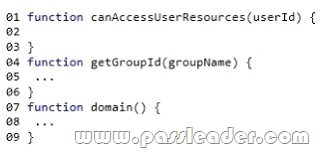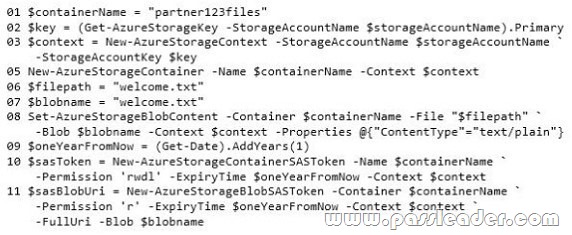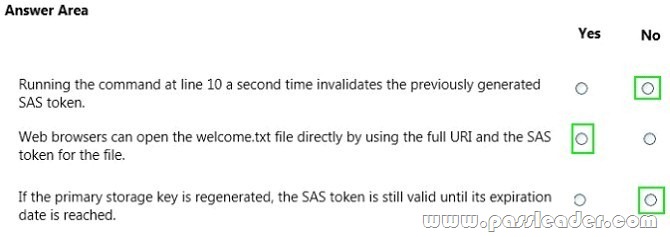Valid 70-532 Dumps shared by PassLeader for Helping Passing 70-532 Exam! PassLeader now offer the newest 70-532 VCE dumps and 70-532 PDF dumps, the PassLeader 70-532 exam questions have been updated and ANSWERS have been corrected, get the newest PassLeader 70-532 dumps with VCE and PDF here: http://www.passleader.com/70-532.html (254 Q&As Dumps –> 300 Q&As Dumps –> 340 Q&As Dumps)
BTW, DOWNLOAD part of PassLeader 70-532 dumps from Cloud Storage: https://drive.google.com/open?id=0B-ob6L_QjGLpfmZSUFFPa0F4WENQMGl3SjhPSkpaTWlzakMwRzF6d2ctUWRTa1V4TTU1c0E
QUESTION 61
A company creates an API and makes it accessible on an Azure website. External partners use the API occasionally. The website uses the Standard web hosting plan. Partners report that the first API call in a sequence of API calls occasionally takes longer than expected to run. Subsequent API calls consistently perform as expected. You need to ensure that all API calls perform consistently. What should you do?
A. Configure the website to use the Basic web hosting plan.
B. Enable Always On support.
C. Configure the website to automatically scale.
D. Add a trigger to the web.config file for the website that causes the website to recycle periodically.
Answer: B
QUESTION 62
Hotspot Question
You have a cloud service that runs an external process that is named MyStartupTask.cmd. The cloud service runs this external process when the web role starts. The external process writes information to the Windows registry. You set the value of an environment variable named MyID to the deployment ID for the current web role instance. The external process must complete writing the information to the Windows registry before the web role starts to accept web traffic. You need to configure the cloud service. How should you complete the relevant markup? To answer, select the appropriate option or options in the answer area.

QUESTION 63
Drag and Drop Question
You deploy an application as a cloud service to Azure. The application contains a web role to convert temperatures between Celsius and Fahrenheit. The application does not correctly convert temperatures. You must use Microsoft Visual Studio to determine why the application does not correctly convert temperatures. You need to debug the source code in Azure. Which three actions should you perform in sequence? To answer, move the appropriate actions from the list of actions to the answer area and arrange them in the correct order.

QUESTION 64
Drag and Drop Question
Your team uses a proprietary source control product. You use FTP to manually deploy an Azure website. You must move your source code from the proprietary source control product to a secure on-premises Git versioning system. Instead of deploying the website by using FTP.the website must automatically deploy to Azure each time developers check-in source files. You need to implement the new deployment strategy. Which three actions should you perform in sequence? To answer, move the appropriate actions from the list of actions to the answer area and arrange them in the correct order.

QUESTION 65
You create a software-as-a-service (SaaS) application. Websites, cloud services, and virtual machines (VMs) read common data values from the database for the application. The application does not scale efficiently. All VMs, websites, and cloud services must read from the same data source. You need to design a cache solution for the SaaS application. What should you do?
A. Deploy a cache by using Azure Redis Cache.
Access the cache from the websites, cloud services, and VMs.
B. Configure a cache by using ASP.NET.
Access the cache from the websites, cloud services, and VMs.
C. Use Azure Redis Cache to deploy one cache for each website, one cache for each cloud service, and one cache for each VM.
Configure each cache to ensure that data is consistent in all the cache instances.
D. Deploy a cache by using Azure Redis Cache.
Configure the cache to use database connection strings.
Answer: A
QUESTION 66
You are designing an upgrade strategy for a Windows Azure application that includes one web role with one instance. You have the following requirements:
– Test the application on the Windows Azure platform.
– Ensure that application upgrades can be rolled back.
– Ensure that upgrade and rollback processes do not cause downtime.
You need to recommend an approach for upgrading the application. What should you recommend?
A. Deploy to the Production slot.
Test the application, and then perform a VIP swap.
B. Deploy to the Staging slot.
Test the application, and then perform a VIP swap.
C. Deploy to the Staging slot.
Test the application, and then perform a manual in-place upgrade to the Production slot.
D. Deploy to the Staging slot.
Test the application, and then perform an automatic in-place upgrade to the Production slot.
Answer: B
Explanation:
Run Set-AzureDeploymentSlot from the service directory to set the deployment environment for the current service to either Staging or Production. This updates the DeploymentSettings.json file for the service. A hosted service is a service that runs your code in the Windows Azure environment. It has two separate deployment slots: staging and production. The staging deployment slot allows you to test your service in the Windows Azure environment before you deploy it to production. You can upgrade your service by deploying a new package to the staging environment and then swapping the staging and production deployments. This type of upgrade is called a Virtual IP or VIP swap, as it swaps the addresses of the two deployments. Both deployments remain online during the swap process. You can swap VIPs using the Windows Azure Platform Management Portal, or by using the Service Management API. If you are upgrading your service with a new service definition file, you must swap VIPs; you cannot perform an in-place upgrade. However, you can swap VIPs only if the number of endpoints specified by the service definition is identical for both deployments. For example, if you add an HTTPS endpoint to a web role that previously exposed only an HTTP endpoint, you cannot upgrade your service using a VIP swap; you’ll need to delete your production deployment and redeploy instead.
QUESTION 67
You are migrating a solution to Windows Azure. The solution includes a web application and a business logic layer. The web application runs on three dual-core servers. The business logic layer runs on two quad-core servers. The Windows Azure application must match or exceed the current hardware specifications. You need to recommend role instance sizes that minimize cost. What should you recommend?
A. Small for the web application and Medium for the business logic layer
B. Small for the web application and Large for the business logic layer
C. Medium for the web application and Large for the business logic layer
D. Large for the web application and Extra Large for the business logic layer
Answer: C
Explanation:
http://msdn.microsoft.com/en-us/library/windowsazure/ee814754.aspx
QUESTION 68
You are designing an automated deployment process for a Windows Azure application. The process must deploy the application to Windows Azure without any user interaction. You need to recommend a deployment strategy. What should you recommend?
A. Use the Service Management API to deploy the application package.
B. Use the cspack and csrun command-line utilities and pass the cloud project as an argument.
C. Publish the cloud project to a local directory and upload the application package to Windows Azure Blob storage.
D. Publish the cloud project to a local directory and use the Windows Azure Developer Portal to upload the application.
Answer: A
QUESTION 69
A Windows Azure application is running in the development fabric. You need to recommend an approach for deploying the application to Windows Azure. What should you recommend?
A. Use XCopy deployment.
B. Use the Windows Azure AppFabric.
C. Use the Windows Azure Storage Services REST API.
D. Use the Windows Azure Tools for Microsoft Visual Studio 2010.
Answer: D
QUESTION 70
You are modifying a web application so that it uses Azure Active Directory to manage users. You create a security group named Users and a security group named Administrators. The Administrators security group is a member of the Users security group. You create the following code segment. Line numbers are included for reference only.

You need to implement the canAccessUserResources function. Which code segment should you insert at line 02?
A. Option A
B. Option B
C. Option C
D. Option D
Answer: C
QUESTION 71
Hotspot Question
Your company works with trusted partners. These partners upload files into a storage account that you control. Partners must be able to create, read, and write files. Partners must NOT be allowed to see files from other partners. You generate a shared access signature (SAS) for each partner. You create the following Windows PowerShell script to create a new container for each partner. Line numbers are included for reference only.

For each of the following statements, select Yes if the statement is true. Otherwise, select No.

QUESTION 72
A company maintains an Azure storage account. The storage account uses blobs and tables. Customers access the storage account by using shared access signatures (SASs). You need to monitor the usage of the storage services. You need to do the following:
– Understand which storage areas perform operations that incur a fee.
– Understand which requests are denied because of insufficient permissions.
– Validate that the performance of the storage account meets the service level agreement (SLA) for the Azure Storage service.
Which three data analysis tasks should you perform? Each correct answer presents part of the solution.
A. Use data from the logs of the storage services to find individual storage access attempts that do not comply with the SLA.
B. Use data from the logs of the storage services to calculate aggregate server latency across individual requests. Determine whether the results of this calculation indicate that the Azure Storage service is in compliance with the SLA.
C. Analyze the logs of the storage services to determine which storage services were inaccessible because of permissions issues.
D. Review the Azure documentation to determine which storage operations are billable.
Then find records of those operations in the logs of the storage services.
E. Analyze the logs of the storage services to find records of operations that are marked as billable.
F. Correlate the data logged from the storage service with the permissions to store data in the individual blobs and containers.
Determine which storage services were inaccessible because of permissions issues.
Answer: BCD
Get the newest PassLeader 70-532 VCE dumps here: http://www.passleader.com/70-532.html (254 Q&As Dumps –> 300 Q&As Dumps –> 340 Q&As Dumps)
And, DOWNLOAD the newest PassLeader 70-532 PDF dumps from Cloud Storage for free: https://drive.google.com/open?id=0B-ob6L_QjGLpfmZSUFFPa0F4WENQMGl3SjhPSkpaTWlzakMwRzF6d2ctUWRTa1V4TTU1c0E




